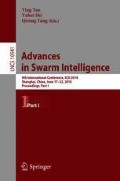Abstract
The article presents a multi-species object-based model of a marine plankton community. The model was constructed using the synthesis of Lagrangian and Eulerian descriptions: we described the living components of an ecosystem by the individual-based approach and the non-living components (hydrochemical fields) – in a traditional way as concentrations in the nodes of a regular computational grid. A set of interacting objects simulated a plankton community. Each object modeled behavior of a group of identical plankters characterized by species, age, stage of development, biomass, abundance, and rates of physiological processes. Bioenergetic interaction between the objects and the environment was a source of population dynamics. We studied self-organization of plankton spatial distribution with no significant hydrophysical influences. Lloyd’s index of mean crowding, spectral and wavelet analyses were used to investigate patterns of simulated spatial variability. We compared spectra of simulated plankton patchiness with those estimated according to observation data collected by the Video Plankton Recorder (VPR).
Access this chapter
Tax calculation will be finalised at checkout
Purchases are for personal use only
References
Abraham, E.A.: The generation of plankton patchiness by turbulent stirring. Nature 391, 577–580 (1998)
Ashjian, C.J., Davis, C.S., Gallager, S.M., Alatalo, P.: Distribution of plankton, particles, and hydrographic features across Georges Bank described using the Video Plankton Recorder. Deep-Sea Res. II. 48, 245–282 (2001)
Ashjian, C.J.: VPR_ashjian_nonzero. Biological and Chemical Oceanography Data System. BCO DMO, WHOI. iPub: 26 July 2012. http://www.bco-dmo.org/dataset-deployment/455332/data. Accessed 10 Feb 2015
Batchelder, H.P., Speirs, D.C., Gentleman, W.C.: Workshop on “Individual-based models of Zooplankton”. PICES Press 19, 18–21 (2011)
Folt, C.L., Burns, C.W.: Biological drivers of Zooplankton patchiness. Trends Ecol. Evol. 14, 300–305 (1999)
Grimm, V., Railsback, S.F.: Agent-based models in ecology: patterns and alternative theories of adaptive behaviour. In: Billari, F., Fent, T., Prskawetz, A., Scheffran, J. (eds.) Agent-Based Computational Modelling – Applications in Demography, Social, Economic and Environmental Sciences. Contributions to Economics, pp. 139–152. Physica, Heidelberg (2006)
James, E.C., Andrea, E.A., Brian, E.C., Heller, T.: Seasonal changes in the spatial distribution of phytoplankton in small, temperate-zone lakes. J. Plank. Res. 14, 1017–1024 (1992)
Khailov, K.M., Popov, A.E.: Concentration of live mass as a regulator of aquatic organism functioning. Ekol. Morya 15, 3–15 (1983)
Lange, M.: Embedding individual-based plankton ecosystem models in a finite element ocean model. Imperial College London, Department of Computing. Thesis, 188 p. (2014). https://spiral.imperial.ac.uk/handle/10044/1/18051
Lloyd, M.: Mean crowding. J. Anim. Ecol. 36, 1–30 (1967)
Miller, T.J.: Contribution of individual-based coupled physical biological models to understanding recruitment in marine fish populations. Mar. Ecol. Prog. Ser. 347, 127–138 (2007)
Pinel-Alloul, B.: Spatial heterogeneity as a multiscale characteristic of Zooplankton community. Hydrobiologia 300(301), 17–42 (1995)
Piontkovski, S.A., Williams, R.: Multiscale variability of tropical ocean Zooplankton biomass. ICES J. Mar. Sci. 52, 643–656 (1995)
Shushkina, E.A., Vinogradov, M.E., Lebedeva, L.P.: Processes of detritus production and fluxes of organic matter from epipelagic zones in different ocean regions. Oceanology 40, 183–191 (2000)
Tzella, A., Haynes, P.H.: Small-scale spatial structure in plankton distributions. Biogeosciences 4, 173–179 (2007)
Vasechkina, E.F., Yarin, V.D.: Modeling of the dynamics of age structure of the populations of free-floating copepods in the Black Sea. Phys. Oceanogr. 20, 58–75 (2009)
Vasechkina, E.F., Yarin, V.D.: Object-oriented model of functioning of the plankton community of the shelf. Phys. Oceanogr. 14, 360–376 (2004)
Vasechkina, E.: Appendix. Energy balance model of a plankton object. https://www.researchgate.net/publication/324521863_Energy_balance_model_of_a_plankton_object
Vinogradov, M.E., Shushkina, E.A., Kukina, I.N.: Functional characteristic of the plankton community of equatorial upwelling. Oceanology 16(1), 122–137 (1976)
Author information
Authors and Affiliations
Corresponding author
Editor information
Editors and Affiliations
Rights and permissions
Copyright information
© 2018 Springer International Publishing AG, part of Springer Nature
About this paper
Cite this paper
Vasechkina, E. (2018). Self-organization of Small-Scale Plankton Patchiness Described by Means of the Object-Based Model. In: Tan, Y., Shi, Y., Tang, Q. (eds) Advances in Swarm Intelligence. ICSI 2018. Lecture Notes in Computer Science(), vol 10941. Springer, Cham. https://doi.org/10.1007/978-3-319-93815-8_4
Download citation
DOI: https://doi.org/10.1007/978-3-319-93815-8_4
Published:
Publisher Name: Springer, Cham
Print ISBN: 978-3-319-93814-1
Online ISBN: 978-3-319-93815-8
eBook Packages: Computer ScienceComputer Science (R0)

